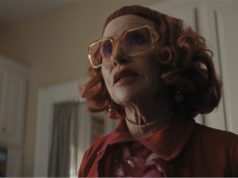
The Avengers continues as America’s top box-office draw, and as usual, I have way more thoughts than I could put into my review of the movie. Let’s go.
We start with Joss Whedon’s thank-you note to his loyal fans who’ve been with him since his Buffy the Vampire Slayer days. Besides being utterly charming, it’s also a first-person account of what it’s like to have one’s movie shatter box-office records left and right, an experience that few people ever enjoy and fewer still think to write about as it’s happening. Whedon is a garrulous sort who likes to give interviews, but Adam Rogers’ profile of him in Wired is a superior piece of journalism.
On Deadspin, Grierson & Leitch think Whedon getting the assignment is unusual, but I don’t share that opinion. Through the whole Avengers series, Marvel has pursued a strategy of hiring talented directors who aren’t on the A-list. Instead, they hire filmmakers who are on the up (Jon Favreau for the Iron Man films) or have hit a wall (Kenneth Branagh for Thor). In this company, Whedon’s hiring fits the pattern. It’s not just Marvel, either: Christopher Nolan was relatively untested when Warner Bros. handed the keys to the Batman series, Sam Raimi was mostly known as a cult figure (despite the critical acclaim for his A Simple Plan) when Sony tapped him for Spider-Man, Bryan Singer had only had one word-of-mouth hit (The Usual Suspects) before snagging X-Men, Matthew Vaughn’s films were only hits in Britain (Kick-Ass, Layer Cake) before he took over for Singer, and Marc Webb inherits Spider-Man after having directed only one other film ((500) Days of Summer). Going way back, Tim Burton was a considered an oddball choice when he was picked to revive Batman. There’s hard financial sense behind these hirings — outsider directors work for cheaper than Steven Spielberg or Michael Bay. The practice isn’t foolproof, but it has worked pretty well so far.
That’s what we should point out to the minority of people who aren’t on the Avengers bandwagon. I’m not talking about those who don’t care for the movie itself, but rather for those who acknowledge the movie’s quality but are choosing to have a big old sad about it. It takes a perverse mindset to do that, but you do understand where they’re coming from. After all, the success of The Avengers is only going to spawn more movies like it and discourage Hollywood even further from making literate dramas and prestige pictures. Still, I’m not sure the success or failure of one movie changes the climate in Hollywood. Last year Dana Stevens asked what if they made a blockbuster and nobody showed up, forgetting that exactly such a thing happened last year with Green Lantern. Its failure didn’t force any decision makers in Tinseltown to re-evaluate their priorities. (It did kill off any talk of a Justice League movie, although the success of The Avengers has rekindled it, ironically enough.) Since we’re going to have superhero blockbusters that will pull in giant audiences regardless of the circumstances, we’re all better off if those movies are good. The best way to do that is to hand those films to talented artists and give them some creative freedom. Zach Baron speaks as if these talented artists are now imprisoned by their success, and it’s true Downey, Ruffalo, etc. are tethered by contracts. However, artistry can still be done within the framework of these big-budget comic-book franchise movies. Besides, people can always quit. Alfonso Cuarón walked away from the Harry Potter series, and Gary Ross has just left The Hunger Games. Some artists do put their artistry away so they can cash big checks, but there’ll always be people who want to keep challenging themselves after they’ve made bank.
Scarlett Johansson’s Black Widow gives the movie a welcome female presence, which Whedon expressed somewhat inelegantly in his Wired interview, but she also fits in with Whedon’s penchant for creating hot women who can snap your spine. Such characters pop up repeatedly in his work, and what I’ve noticed is, they’re all different from each other. Black Widow is a reformed villain seeking atonement. By contrast, Buffy the Vampire Slayer is a smart-mouthed teenager, Zoe from Firefly/Serenity (Gina Torres) is a conventional homebody, River from Firefly/Serenity (Summer Glau) is a mentally disturbed little girl, and Echo from Dollhouse (Eliza Dushku) is an idealistic do-gooder. That’s just his TV shows. In movies with Whedon as a credited screenwriter, Alien: Resurrection’s Call (Winona Ryder) is a self-hating closet case, and Titan A.E.’s Stith (voiced by Janeane Garofalo) just likes to destroy stuff. (By the way, did you forget that Whedon wrote Titan A.E. because you forgot the existence of that film entirely? I did.) Look at Tim Burton’s porcelain-skinned blonde waifs, who are all pretty much the same, and you’ll see that Whedon’s badass women come in a lot of varieties.
Speaking of which, Whedon is one of many filmmakers who tried and failed to get a Wonder Woman movie off the ground. Warner Brothers had him under contract, but he had a falling out with the studio over the project’s direction. How ironic! Had he been able to do that film, he could have helped launch a series of Justice League movies that would have been made by Warner Bros. Ironically, in the world of comic books, the Justice League came first and the Avengers were latecomers. Now, the situation is reversed in the movie world. My comic-book expertise isn’t the best; when I saw the movie’s first post-credit sequence, I had no idea who the grinning alien dude was. (Here’s an explanation.) I do have a few tidbits for the comics crowd, though: Janet van Dyne a.k.a. The Wasp almost made it into the Avengers’ movie. Other Marvel characters won’t be making it into the series because they’re licensed to other studios: Spider-Man belongs to Sony, while Wolverine and the other X-Men are properties of Fox. On Grantland, Alex Pappademas writes a fascinating piece on the whole dust-up over Jack Kirby and his creative input on Marvel’s greatest creations. Oh, and Edgar Wright is still working on Ant-Man. Having seen what Wright can do with serious money on Scott Pilgrim vs. the World, I’m salivating over the prospect of him doing one of these films.
Today comes the news that Robert Downey Jr. is earning $50 million for his work on The Avengers. If that sounds like a lot of money, well, it is. It’s much more than his fellow actors on the project earned, because he or his representatives inserted clauses into his contract giving him a slice of the profits. Grantland’s Amos Barshad argues that he deserves the money because his character has the best lines. I’ve got a better argument: The Avengers doesn’t happen without the success of Iron Man, and Iron Man doesn’t succeed without Downey. The 2008 movie was a case of the right role finding the right actor at the right time. No one else could have played Tony Stark to such powerful effect, not even Downey’s younger self, because no one else had his talents combined with his past as a drug addict whose antics in the late 1990s and early 2000s genuinely terrified those who knew him. Iron Man was his first starring role after he finally got clean, and he looks haunted by his survival, which jibes with the character of a successful middle-aged man who one day realizes that he’s been misusing his talents and needs to change his life. What we know about the actor’s past helps make the movie so indelible. Both Downey and the movie deserved Oscar consideration, but The Dark Knight came along later that same summer and sucked away most of the critical adulation that year. (And now Christopher Nolan’s got The Dark Knight Rising coming along later this summer. Could he repeat the trick?) So Downey deserves his $50 mil, which isn’t that much when you consider that The Avengers’ box office take is at $1 billion and climbing. If it were up to me, I’d pay all the stars $50 million apiece, but then, that’s probably why I’m not running a Hollywood studio.
Other websites go wonky over the physics of the series. I went wonky over SHIELD’s naval aircraft carrier that can fly (which is apparently called the Helicarrier), so I asked an aeronautics expert about it. Namely, my brother Wesley Lin, who works as an aerospace engineer. I asked him how possible the Helicarrier would be in real life. He says it’s not, at least not with existing technology. “It’s hard to see how a huge aircraft could stay in the air for long periods of time with just fossil fuel,” he says. “It might be possible to build a large nuclear-powered aircraft, but then it would be very hard to protect the crew from the radiation and still have an aircraft light enough to fly.” Plus, smaller aircraft would have trouble landing on a vessel that’s also airborne, though I don’t believe that happens in the film — the plane that brings Barton and his team of commandos to attack the Helicarrier might just have hovered low over the deck, with the men rappelling or jumping out. Of course, the implausibility of the Helicarrier doesn’t come near the implausibility of Tony Stark’s artificial heart or Bruce Banner turning into a huge green rage monster. Still, I found it an interesting avenue of inquiry.
Elsewhere, Clothes on Film has this insightful look at Alexandra Byrne’s costume design. John Perich on Overthinking It analyzes how Nick Fury conducts war. I highly recommend casual fans check out Whedon’s Dr. Horrible’s Sing-Along Blog, a musical web series produced during the 2007 writers’ strike that stars Neil Patrick Harris as a bumbling supervillain who keeps being defeated by Nathan Fillion’s douchebag superhero, Captain Hammer. Somehow Whedon kept from having Thor say, “The hammer is my penis.” Whedon’s first cut of the film ran for three hours, and it sounds like much of the footage that he cut out will make it onto the DVD release. I can’t wait.












Kristian continues to provide the best Blotch contributions, always complete, and compelling. Should be found on the printed page, but I am happy to find it here.
He also cracks me up.